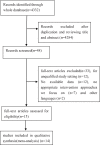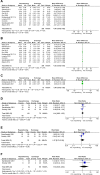Surgical management of intraocular lens dislocation: A meta-analysis
- PMID: 30785910
- PMCID: PMC6382138
- DOI: 10.1371/journal.pone.0211489
Surgical management of intraocular lens dislocation: A meta-analysis
Abstract
Purpose: To compare the efficacy and safety of intraocular lens (IOL) repositioning and IOL exchange for the treatment of patients with IOL dislocation.
Methods: We systematically searched for relevant publications in English or Chinese in MEDLINE, Embase, the Cochrane Central Register of Controlled Trials, WHO International Clinical Trial Registration Platform, Clinical Trial.gov, China Biology Medicine Database, China National Knowledge Infrastructure Database and grey literature sources. Study quality was assessed using the STROBE template for observational studies and the Cochrane template for randomized controlled trials (RCTs). Data were meta-analyzed using RevMan 5.3.
Results: The review included 14 English-language studies reporting 1 RCT and 13 retrospective case series involving 1,082 eyes. Average follow-up time was 13.7 months. Pooled analysis of 10 studies showed that the two procedures had a similarly effect on best corrected visual acuity (MD -0.00, 95%CI: -0.08 to 0.08, P = 0.99). Pooled analysis of nine studies showed no significant difference in incidence of IOL redislocation (RR 2.12, 95%CI 0.85 to 5.30, P = 0.11); pooled analysis of seven studies showed greater extent of incidence of cystoid macular edema in IOL exchange (RR 0.47, 95%CI 0.21 to 1.30, P = 0.06). Pooled analysis of three studies showed greater extent of incidence of anterior vitrectomy in IOL exchange (RR 0.11, 95%CI 0.04 to 0.33, P<0.0001). Pooled analysis of two studies showed greater postoperative spherical equivalents in IOL repositioning (MD 1.02, 95%CI 0.51 to 1.52, P<0.0001). pooled analysis suggested no significant differences between the two procedures in terms of intraocular pressure, endothelial cell density, surgically induced astigmatism, or incidence of retinal detachment, intraocular hemorrhage or pupillary block.
Conclusion: IOL repositioning and exchange are safe and effective procedures for treating IOL dislocation. Neither procedure significantly affects best corrected visual acuity and IOL redislocation. IOL exchange was superior to repositioning in terms of postoperative SE, but IOL repositioning was associated with lower incidence of anterior vitrectomy, potentially lower incidence of cystoid macular edema.
Conflict of interest statement
The authors have declared that no competing interests exist.
Figures










Similar articles
-
A comparison of visual results and complications in eyes with posterior chamber intraocular lens dislocation treated with pars plana vitrectomy and lens repositioning or lens exchange.Ophthalmology. 2001 Jan;108(1):82-9. doi: 10.1016/s0161-6420(00)00410-3. Ophthalmology. 2001. PMID: 11150269
-
Late In-the-Bag Intraocular Lens Dislocation: A Randomized Clinical Trial Comparing Lens Repositioning and Lens Exchange.Ophthalmology. 2017 Feb;124(2):151-159. doi: 10.1016/j.ophtha.2016.10.024. Epub 2016 Nov 30. Ophthalmology. 2017. PMID: 27914839 Clinical Trial.
-
Pars plana vitrectomy combined with iris-claw intraocular lens implantation for lens nucleus and intraocular lens dislocation.J Cataract Refract Surg. 2014 Sep;40(9):1488-97. doi: 10.1016/j.jcrs.2013.12.025. J Cataract Refract Surg. 2014. PMID: 25135541
-
[Sutureless scleral intraocular lens fixation: report of nine cases and literature review].J Fr Ophtalmol. 2013 Oct;36(8):658-68. doi: 10.1016/j.jfo.2012.09.009. Epub 2013 Jul 25. J Fr Ophtalmol. 2013. PMID: 23891322 Review. French.
-
Cystoid macular oedema and iris-fixated intraocular lens treated with intraocular lens exchange: A case series and review.J Int Med Res. 2019 Jan;47(1):188-195. doi: 10.1177/0300060518799004. Epub 2018 Oct 1. J Int Med Res. 2019. PMID: 30270801 Free PMC article. Review.
Cited by
-
Short-term outcomes of implanting a retropupillary iris-claw intraocular lens in patients with lens and intraocular lens drops.Narra J. 2024 Aug;4(2):e892. doi: 10.52225/narra.v4i2.892. Epub 2024 Aug 10. Narra J. 2024. PMID: 39280313 Free PMC article.
-
Iris Fixation for Intraocular Lens Dislocation: Relocation with Iris Suture Versus Exchange to Sutureless Iris Claw IOL.J Clin Med. 2024 Oct 30;13(21):6528. doi: 10.3390/jcm13216528. J Clin Med. 2024. PMID: 39518666 Free PMC article.
-
Late spontaneous posterior capsule rupture with single-piece hydrophobic acrylic intraocular lens dislocation.Sci Rep. 2024 Feb 9;14(1):3368. doi: 10.1038/s41598-024-53934-z. Sci Rep. 2024. PMID: 38336847 Free PMC article.
-
EVALUATION AND MANAGEMENT OF POST-OPERATIVE COMPLICATIONS FOLLOWING CATARACT EXTRACTION AND INTRAOCULAR LENS PLACEMENT.Adv Ophthalmol Optom. 2024 Aug;9(1):133-151. doi: 10.1016/j.yaoo.2024.02.007. Epub 2024 Mar 15. Adv Ophthalmol Optom. 2024. PMID: 39247851 Free PMC article.
References
Publication types
MeSH terms
LinkOut - more resources
Full Text Sources
Medical

